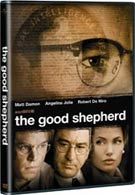I think just about everyone knows that the real spy game isn’t made up of gadgets and constant explosions. Real spies don’t always get to travel to picturesque locations and they don’t always get the girl. So why do we love fictitious spies like James Bond or Jason Bourne? Because the alternative, realistic spy Edward Wilson, is a reminder of just how boring real spy work can be. Robert De Niro’s pet project The Good Shepherd was reportedly in stages of planning for ten years before the actor-returned-to-directing stepped behind the camera for the first time since 1993’s Bronx Tale. The film follows twenty years in the life of Edward Wilson (Matt Damon) as his career in counterintelligence blossoms, his marriage falls apart, and the Central Intelligence Agency is founded around him. Watching The Good Shepherd feels like those twenty years of story and ten years of planning are passing by… in real time.
The movie clocks in at almost three hours and moves at a snail’s pace. The focus of the film seems to be the development of the C.I.A. As Wilson is faced with a leak in intelligence during the famed Bay of Pigs invasion, we look back at his life at similar situations and memories. Those memories are not only limited to his professional career becoming a spy and building relationships with foreign intelligence agencies. They also reflect back on a love lost, a forced marriage failing, and his estranged relationship with his son.
The problem is that Wilson, as portrayed by Damon, is a listless, stone-faced, stoic man. He responds to everything with the same look of passiveness. The girl he had a one-night stand with gets pregnant so he has to leave his true love. Passiveness. The professor he’s been working with proves to be a secret agent. Passiveness. The country is on the brink of war because of failed Intelligence. Passiveness. The years pass, but Wilson’s expression never does. From the very start he’s a man driven by a sense of duty and despite that duty costing him everything he holds dear (or passively dear), he continues to be driven until the very end, with only one real surge of emotion. Don’t expect to see that in his early, vulnerable years however. Emotion doesn’t set in until past the two hour mark.
Time passing is a major problem with the movie, not only because of Wilson’s lack of change as a character, but also because of Matt Damon’s dashing young looks. Wilson’s wife, played by Angelina Jolie, gets older as the movie proceeds, but over a span of twenty years Damon just gets a little greyer. It’s hard to look at the character’s lack of aging between World War II and the Bay of Pigs seriously. Some people may take that criticism as a nitpick, but when the movie spends so long focusing on a character’s stone-faced gaze, you can’t help but notice how little they change over two and a half hours.
I’m sure De Niro had a very personal attachment to The Good Shepherd and the story he was trying to tell. Unfortunately it turns out to be a case of trying to tell too long a story with too many unnecessary side plots. Trying to tell a real spy story without explosions, gadgets, or sexy girls with hot names is admirable, but without those distractions and with such a stoic character at the center, focus to one central story needs to be the key instead of an in-depth character study of someone who just isn’t that interesting. De Niro should have culled his herd and released a much simpler and more focused Shepherd. You have to love how far DVD technology has come over the years. A couple of years ago Titanic had to be released on flipper discs in order to be seen. Now, the nearly three hour Good Shepherd all fits on one disc. Of course, with that length of a movie, there isn’t much room for bonus materials, which, actually, is absolutely fine by me.
The only bonus features for this single disc release are deleted scenes. That’s right, sixteen more minutes of the movie that were cut. You’ll frequently read reviews that comment on deleted scenes being the kind that were appropriate to cut. That certainly holds true here. In fact, there probably should be more deleted scenes and less actual movie. Nevertheless, the deleted scenes include some interesting scenes that actually hold up with anything still in the movie on a quality level, so I can’t complain about them too much.
Most likely due to disc size constraints, those deleted scenes are it. No commentary from Robert De Niro or any kind of behind the scenes material. While I dislike the movie’s somber demeanor and length, I have to admit being a little disappointed at that. It would have been nice to find out just what De Niro saw in this project – what story he was really trying to tell. Then I feel like I could gauge how successful he was with the film. Instead, this is a miniature quality DVD release for a disappointing spy picture.

Star Trek Discovery’s L’ak Actor Told Us About Learning His Character's Most Exciting Details At A Point When He Couldn't Immediately Freak Out

‘P. Diddy’s On The Bottom Of The List Of People I Wanted To Meet, Especially After Finally Meeting Him.’ That Time Conor McGregor Got Real About Running Into Sean Combs

Young Sheldon Revealed How He Picked His Future College, And The Story Was Far More Entertaining Than I Expected
Most Popular



